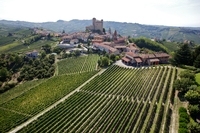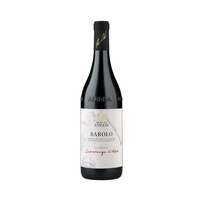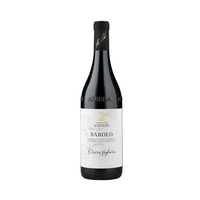Winemaking has also changed dramatically over this short span, with use of small, toasty oak barrels rising quickly but then falling just as fast, mostly in favor of larger, less impactful vessels for fermentation and aging in a more traditional manner. Generational change within established families and purchases of estates by new players from the outside are also factors that have fueled the dynamism that marks Barolo these days.
I could go on and cite other evolving aspects, but you get the idea. I’ve traveled to Barolo (and nearby Barbaresco and Roero) 16 times during the past 14 years to try to stay abreast of developments, but I confess that I often feel outrun. That’s no reason to quit trying, of course, and my love of the wines and fascination with the area will keep me pressing to track changes as best I can.
Among my main tactics is to avoid being blinded by the brilliance of the most famous producers so that I can identify newer, less renowned ones that are making excellent wines before they command prices that put them out of reach for my readers. One such producer is the Rossi Cairo family, which purchased Tenuta Cucco in 2015. They turned out a single village wine in the following year that  grabbed my attention when tasting blind through hundreds of Barolos in January of 2019, and I’ve had my eye on their estate in Serralunga d’Alba ever since.
grabbed my attention when tasting blind through hundreds of Barolos in January of 2019, and I’ve had my eye on their estate in Serralunga d’Alba ever since.
This is not quite a family of “outsiders,” as they are the owners of one of the most important estates in the nearby Gavi district, La Raia, a Demeter-certified biodynamic farm of 180 hectares (445 acres) with 50 hectares of vineyards. The family purchased the estate in 2003, so it is fair to characterize them as relatively new players in the broader region while also acknowledging that they have “jumped in with both feet” at a very high level in Piedmont.
I have yet to visit either estate, but after tasting two new “Cru” (or single site) wines from the Cerrati MGA in the 2019 vintage earlier this year, it seems advisable to publish something about the Serralunga property as its wines are just rising on the Barolo horizon.
They aren’t yet widely available in the USA, but I’m confident that that will change soon, and “to be forewarned is to be forearmed” for those who will wish to try these relatively small-production Barolos. At this point, I’ve had to guesstimate prices based on some approximate information, so you may find pricing that’s a bit higher or lower. Here are three wines to watch for:
Tenuta Cucco, Barolo del Comune di Serralunga d’Alba, Piedmont, Italy, 2019 ($60): This 2016 rendition of this wine put this producer front and center on my radar screen, so I was delighted to taste this vintage and to learn also that Tenuta  Cucco is now also making Cru (or MGA) wines from Serralunga. But before we get to those, this wine has absolutely not lost even a sliver of quality because single-site wines were brought into play, and this 2019 is—to my admitted surprise—at least as good as the 2016 was (and remains: I bought that vintage for my cellar, and tasted a bottle of it alongside all the 2019s). This single village wine shows all the depth and richness and power that one would expect from Serralunga, but not because the fruit was over-ripened or juked up with oak. Although a formidable Nebbiolo-based wine, it also shows excellent purity and fine acidic balance, with wonderful savory accents of carpaccio, spices and leather. It is now more open and expressive than its single-site stablemates, but there’s no reason to believe that it will have a much shorter lifespan, as it not only remained very fresh and solid 24 hours after being opened and double-decanted, but was actually better than when tasted the night before. I may very well have under-scored this. Bloody impressive. 92
Cucco is now also making Cru (or MGA) wines from Serralunga. But before we get to those, this wine has absolutely not lost even a sliver of quality because single-site wines were brought into play, and this 2019 is—to my admitted surprise—at least as good as the 2016 was (and remains: I bought that vintage for my cellar, and tasted a bottle of it alongside all the 2019s). This single village wine shows all the depth and richness and power that one would expect from Serralunga, but not because the fruit was over-ripened or juked up with oak. Although a formidable Nebbiolo-based wine, it also shows excellent purity and fine acidic balance, with wonderful savory accents of carpaccio, spices and leather. It is now more open and expressive than its single-site stablemates, but there’s no reason to believe that it will have a much shorter lifespan, as it not only remained very fresh and solid 24 hours after being opened and double-decanted, but was actually better than when tasted the night before. I may very well have under-scored this. Bloody impressive. 92
Tenuta Cucco, Barolo, Cerrati MGA, Piedmont, Italy, 2019 ($75): Of the two 2019 MGA releases from Cucco that I tasted (the other being Bricco Voghera), this is the more sleek, delicate and floral of the two. It is rather closed at this stage in its development (which is definitely “a thing” with fine Nebbiolo, as with red Burgundy), but the proportions are just right in terms of fruit, acidity, tannin, and wood. Once the floral notes (violets) are joined by some tertiary savory notes from time in bottle, this will surely be a beauty, and a long-lived one. My score will probably seem low in another five years, but I’m sure it won’t look high, and this may become more expressive by as early as autumn of 2024. That may seem like an odd prediction, but multiple vintners in Barolo, Barbaresco and Roero report that their wines seem to open and shine in the 4th quarter of each year, continuing into the winter. I’ve never heard anyone try to explain this, but I’ve heard it often enough to find it provisionally credible. 93
Tenuta Cucco, Barolo, Bricco Voghera, Piedmont, Italy, 2019 ($75): I’ve yet to visit this estate, and don’t know whether those involved consider Bricco Voghera their standard-bearer site within the Cerrati MGA, but it sure looks and smells and  tastes as though it might well be—at least in the 2019 vintage. Darker and more deeply pigmented than the 2019 Cerrati, it also shows fuller body and deeper flavors. None of those characteristics make it “better” than the Cerrati per se, as of course one could just buy $25 Cabernet from anywhere and get even fuller body and deeper flavors. What you would not get from that Cab, however, is this wine’s wonderful combination of moderate body and highly complex aromas and flavors, which this wine already shows very early in its development. Black fruit tones predominate over red ones, with dark cherry and blackberry coming to mind by analogy, with almost no overtly oaky notes but very appealing spicy topnotes. The flavors are quite deep and persistent, and though the tannins are abundant and assertive, there is more than enough fleshy fruit to keep everything in balance, and also freshening acidity to ensure longevity as this becomes even more complex with time in bottle. Having no prior experience with this cru from this producer, I’m a bit gun-shy about going over 95 points while tasting it in its youth, but it has already earned all 95 of those, and may have more quality in store over time. This was terrific as soon as the cork was pulled, and only got better 24 hours after double-decanting. Cucco is a star on the rise, and prices have a way of rising along with reputations, so keep your eyes peeled. 95
tastes as though it might well be—at least in the 2019 vintage. Darker and more deeply pigmented than the 2019 Cerrati, it also shows fuller body and deeper flavors. None of those characteristics make it “better” than the Cerrati per se, as of course one could just buy $25 Cabernet from anywhere and get even fuller body and deeper flavors. What you would not get from that Cab, however, is this wine’s wonderful combination of moderate body and highly complex aromas and flavors, which this wine already shows very early in its development. Black fruit tones predominate over red ones, with dark cherry and blackberry coming to mind by analogy, with almost no overtly oaky notes but very appealing spicy topnotes. The flavors are quite deep and persistent, and though the tannins are abundant and assertive, there is more than enough fleshy fruit to keep everything in balance, and also freshening acidity to ensure longevity as this becomes even more complex with time in bottle. Having no prior experience with this cru from this producer, I’m a bit gun-shy about going over 95 points while tasting it in its youth, but it has already earned all 95 of those, and may have more quality in store over time. This was terrific as soon as the cork was pulled, and only got better 24 hours after double-decanting. Cucco is a star on the rise, and prices have a way of rising along with reputations, so keep your eyes peeled. 95
